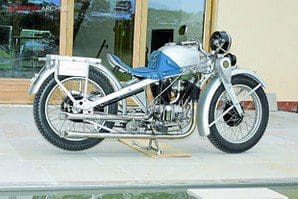
I pride myself on knowing at least something about a wide range of motorcycles, but I freely admit that until recently my knowledge of Neanders amounted to almost zilch. To be precise it amounted to being aware that in the 2008 Bonham’s auction of the late Professor Ehn’s collection, a slightly bizarre looking motorcycle of this name had been sold for an eye-watering amount of money.
Then Sammy Miller comes on the phone with an invitation to pop down and test his latest acquisition. “It’s a Neander,” he says, “and no, it’s not the one from the Ehn collection, it’s on loan from the Hockenheim Motor Museum.” It was rather like the old joke about waiting for a bus. You don’t see one for ages, and then three come along at once. In this case, of course it’s only two, but when a motorcycle is as incredibly rare as the Neander, that counts as a positive glut.
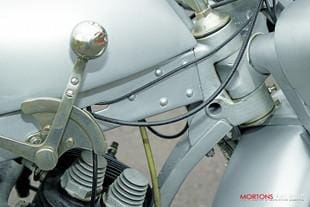 The originator of the Neander was as interesting as his motorcycles, and although genealogists and historians may quibble about the details, his biography goes something like this. Multi-talented Ernst Neumann was born in Kassel, in central Germany, and experimented with steam and petrol powered tricycles before departing for a career as an industrial artist in Munich. He continued that occupation in Paris, where he designed a motorcycle for the Griffon Company; a little-known but quite long-lived concern that survived until after WWII.
The originator of the Neander was as interesting as his motorcycles, and although genealogists and historians may quibble about the details, his biography goes something like this. Multi-talented Ernst Neumann was born in Kassel, in central Germany, and experimented with steam and petrol powered tricycles before departing for a career as an industrial artist in Munich. He continued that occupation in Paris, where he designed a motorcycle for the Griffon Company; a little-known but quite long-lived concern that survived until after WWII.
Neumann gained a good reputation there, since he was immediately employed as a car stylist in Berlin on his return to Germany, and then he moved on to Rolsdorf to set up his own motorcycle plant. It seems to be about this time that he adopted the name of Neander, and naturally he used that title on his motorcycles. On occasion his name also appeared in the hyphenated Neumann-Neander form that I’ll continue to use to avoid confusion between man and machine.
Why Neander? Well, this is where a bit of supposition comes into the story. If the word sounds vaguely familiar, it’s because most of us have heard of our pre-historic ancestor – Neanderthal man – whose existence was deduced from a skeleton found in the Neander Valley, near Dusseldorf. Well that happens to be quite close to both Kassel and Rolsdorf, and without wishing to delve into the murky depths of religious and political history, I can only suppose that anti-Semitic feeling was already rising in Germany, and Neumann decided to camouflage his Jewish-sounding name by changing to something that was indisputably German and also familiar in the locality.
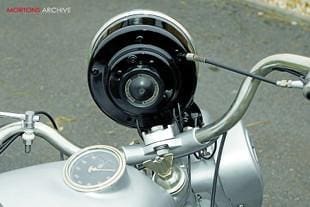 As a multi-talented and well educated man, he may also have known about, and been influenced by, a remarkable historical parallel. Three and a half centuries earlier, another gifted German named Neumann (in this case with the first name of Michael) gained multiple degrees at the University of Wittenberg, before teaching mathematics and astronomy at the University of Jena. The fascinating thing is that for some reason this Neumann, too, chose to change his name to Neander, and his legacy lives on in the name of the Neander crater on the moon.
As a multi-talented and well educated man, he may also have known about, and been influenced by, a remarkable historical parallel. Three and a half centuries earlier, another gifted German named Neumann (in this case with the first name of Michael) gained multiple degrees at the University of Wittenberg, before teaching mathematics and astronomy at the University of Jena. The fascinating thing is that for some reason this Neumann, too, chose to change his name to Neander, and his legacy lives on in the name of the Neander crater on the moon.
Perhaps all that opens up more questions than answers, but what is beyond doubt is that in 1924 Ernst Neumann-Neander began making motorcycles that exploited his own ideas on engineering and styling. Both aspects are combined in the most visually striking thing about the Neander – its pressed steel frame. This gives the machine an unmistakable Germanic air, probably because such chassis became synonymous with all sorts of BMWs and Zundapps during the 1930s and 1940s, while they were usually only seen on small Coventry Eagles in this country.
The Neander’s frame pre-dated its better known compatriots, however, and the design was regarded highly enough, it was licensed to Opel (a maker of two and four-wheeled vehicles until 1930) which made frames in the Elite motorcycle factory it had recently taken over. Just to muddy the waters further, early Neanders were noted for having duralumin frames protected by cadmium plating, while the Elite/Opel ones were made in steel. The test Neander, however, has a steel frame, and it’s anybody’s guess whether the Rolsdorf factory switched to this material towards the end of the decade, or whether the frame was bought in from Opel.
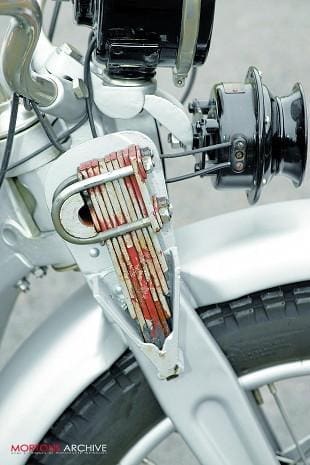 Either way it certainly gives the Neander a neat and purposeful appearance, the virtually straight members leading from the headstock to the rear wheel spindle promising decent rigidity and handling, while the front down-sections are elegantly curved to mirror the arc of the front mudguard. Besides tidying the machine’s looks, this brings the front forks much closer to the frame than would be possible with straight sections, and results in a more compact wheelbase than is usual for a large capacity motorcycle in the late-vintage period.
Either way it certainly gives the Neander a neat and purposeful appearance, the virtually straight members leading from the headstock to the rear wheel spindle promising decent rigidity and handling, while the front down-sections are elegantly curved to mirror the arc of the front mudguard. Besides tidying the machine’s looks, this brings the front forks much closer to the frame than would be possible with straight sections, and results in a more compact wheelbase than is usual for a large capacity motorcycle in the late-vintage period.
The simply curved petrol tank sits very neatly above the frame pressing, and its neatness is enhanced by the way that the VDO speedometer is set flush with its surface, rather than being mounted on a detachable panel. The angular oil tank fits equally unobtrusively under the seat, and its otherwise inaccessible filler cap is reached by simply pivoting the saddle up out of the way. Even the pannier tool boxes have a clinical Germanic look to them, their pressed steel lids a sharp contrast to the cosy untidiness of contemporary leather-fronted British boxes. The redundant mounts for the number plate on the front mudguard are over-engineered to the point where they would equally well serve as lifting points, but they are still neatly rounded and nicely finished.
Overall, the influence of Neumann-Neander’s artistic training is clear in the machine’s modernistic flowing lines, and a present-day art student who knew nothing whatever about motorcycles would instantly recognise that the combination of line, curve and functionality exemplifies everything that was good about the art-deco design craze that swept Europe around 1930. I’m only surprised Neumann-Neander didn’t draw up an equally stylistic tank badge.
The styling is even carried through to the forks, although their action is – in a word – weird. What I’ll refer to as the bottom yoke is effectively a large diameter tubular cross member on which the fork legs pivot, while the movement of the legs is controlled by massive leaf springs clamped onto the outer ends of the tube. The result – which I tested along with Sammy Miller’s chief restorer, Bob Stanley – is that the wheel swings forward when the Neander is mounted by a heavy rider (and I really do mean heavy, because it took our combined efforts to have any effect whatsoever), while pushing it against a large obstacle makes it swing back.
 What happens in between is anybody’s guess, but I reckon that a typical obstruction a few centimetres in height would generate a force in line with the headstock and result in no suspension movement at all, and it’s probably significant other motorcycles which had used this kind of fork had disappeared by the late 1920s. There may well have been a conflict between the artistic and engineering sides of the designer’s character, here, as I note that the possibly slightly later Ehn/Bonhams Neander is fitted with conventional girders; but I hope its new owner will forgive me saying that however effective they are, they don’t complement the design anywhere near as well as the pressed steel fork legs and bulbous spring covers on this one.
What happens in between is anybody’s guess, but I reckon that a typical obstruction a few centimetres in height would generate a force in line with the headstock and result in no suspension movement at all, and it’s probably significant other motorcycles which had used this kind of fork had disappeared by the late 1920s. There may well have been a conflict between the artistic and engineering sides of the designer’s character, here, as I note that the possibly slightly later Ehn/Bonhams Neander is fitted with conventional girders; but I hope its new owner will forgive me saying that however effective they are, they don’t complement the design anywhere near as well as the pressed steel fork legs and bulbous spring covers on this one.
Then again, Ernst Neumann-Neander may simply have had a thing about leaf springs, because he employed them again under the pivoted saddle. It’s fortunate these do actually deflect under my weight, as the padding atop the seating area (a steel pressing, naturally) is minimal to say the least, and its most impressive feature is it embodies a little pouch that would just about carry a couple of spark plugs. Nobody could fail to note the unusually shaped saddle, but modern riders might not realise the Neander is quite remarkable for its era in having a centrestand. Considering its designer’s character and background, it’s a toss-up whether he specified this instead of the usual rear wheel stand for aesthetic or practical reasons, but either way he avoided a feature that visually dates most vintage machines.
All the Neander’s careful and innovative design would be a waste of time if it didn’t result in a worthwhile motorcycle, and there’s no reason why this shouldn’t be quite a performer with a powerful V-twin slotted in between the frame pressings. The slightly surprising thing is that this most Teutonic of machines is powered by a British JAP engine, but in fact Neanders used a wide variety of proprietary units from little Villiers two-strokes upwards. When it came to the big range-topping jobs, the original buyer of this one evidently went our side of the channel, while the first owner of the ex-Prof Ehn example was slightly more patriotic and opted for a MAG motor of similar style and capability.
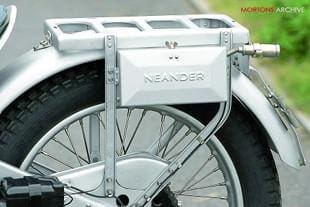 But even if the motor is as British as roast beef, most of the Neander’s ancillary fittings have an unmistakably continental air to them. That imposingly squarish headlamp, for example, would look quite alien on a British motorcycle, and the ‘klaxon’ hooter is clearly made by Bosch, as is the magneto. Other familiar looking parts may be equally continental, as what appears to be a Burman gearbox has ‘Hurth’ embossed on its kick-start cover plate, while the Amac-looking carburettor has a word that looks like ‘Fischer’ almost polished away on its float chamber lid.
But even if the motor is as British as roast beef, most of the Neander’s ancillary fittings have an unmistakably continental air to them. That imposingly squarish headlamp, for example, would look quite alien on a British motorcycle, and the ‘klaxon’ hooter is clearly made by Bosch, as is the magneto. Other familiar looking parts may be equally continental, as what appears to be a Burman gearbox has ‘Hurth’ embossed on its kick-start cover plate, while the Amac-looking carburettor has a word that looks like ‘Fischer’ almost polished away on its float chamber lid.
Riding the Neander takes no special skill, although, as many readers will be aware, there is no such thing as a standardised layout for the controls on vintage machines. The outside lever on the left, for example, is the clutch with the inboard one used for decompression, but it could just as easily be the other way round, and for all I know it may have been at some stage. Likewise the lever on the left hand side of the handlebars, that you might expect to adjust the advance and retard, is actually the choke control. There is, in fact, no magneto control lever because that job is performed by a left-hand twistgrip, as on many early American motorcycles.
At least the front brake lever is in the expected place, the carburettor is controlled by a conventional twistgrip rather than a fiddly lever, and the rear brake control is on the right, which is not at all uncommon on vintage machines whatever their origin. So, with the Neander fired up on the roller starter (unsurprisingly, the kick-start has little effect on this large and unfamiliar museum exhibit) off I go with not a care in the world. Apart, that is, from the slight concern that I’m riding a unique example of a rare marque, and that it’s worth considerably more than I’m likely to earn in the foreseeable future…
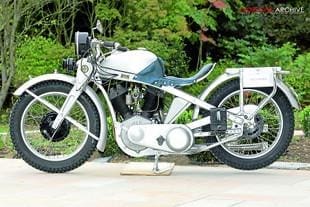 I soon discover the Neander’s impressive looks are matched by its ability on the road. For those who haven’t been fortunate enough to sample a one-litre side-valve JAP motor, I can only say that it epitomises the best of vintage motorcycle engineering. With clean carburation and automatic lubrication it has no real quirks at all, just bottomless torque, a surprising willingness to rev, and if there’s any mechanical noise it’s masked by the wonderfully growling note from its silencer-less exhausts. Its forgiving nature is fortunate, because I freely admit I never came to terms with the gearchange – whose lever’s ‘gate’ has no real detents to tell you which ratio (if any!) you’ve engaged – but I imagine that would come with practise.
I soon discover the Neander’s impressive looks are matched by its ability on the road. For those who haven’t been fortunate enough to sample a one-litre side-valve JAP motor, I can only say that it epitomises the best of vintage motorcycle engineering. With clean carburation and automatic lubrication it has no real quirks at all, just bottomless torque, a surprising willingness to rev, and if there’s any mechanical noise it’s masked by the wonderfully growling note from its silencer-less exhausts. Its forgiving nature is fortunate, because I freely admit I never came to terms with the gearchange – whose lever’s ‘gate’ has no real detents to tell you which ratio (if any!) you’ve engaged – but I imagine that would come with practise.
Despite my reservations about the forks, the handling seems first class, and the Neander is equally happy holding a straight line or cornering as quickly as I dare, the only limitation being the unusual handlebars – they are in two halves, separately clamped into the top yoke – bash into my kneecaps on full lock. The generously sized brakes work much better than most of their contemporaries, and when I come to a halt, the extension somebody has welded onto the centrestand means the Neander can be parked as easily as any bike I’ve met.
It goes almost without saying that Ernst Neumann-Neander suffered the fate of most visionaries, and after producing his elegant, advanced, motorcycles for five years, he went out of business when the economic depression took hold. He spent the next decade working on small motorcars, but they really had no chance against the state-backed Volkswagen, and until his death in 1954 he returned to his first vocation as an artist. Seeing the overwhelming sense of style he’d exhibited as a motorcycle manufacturer, I suspect he was quite content to finish his career in that way.



